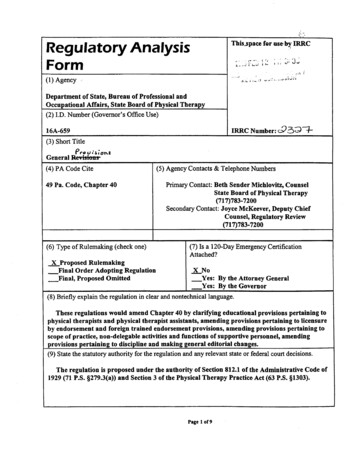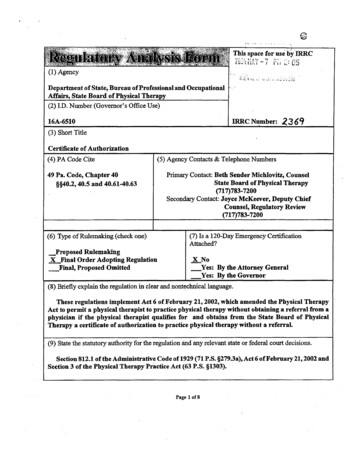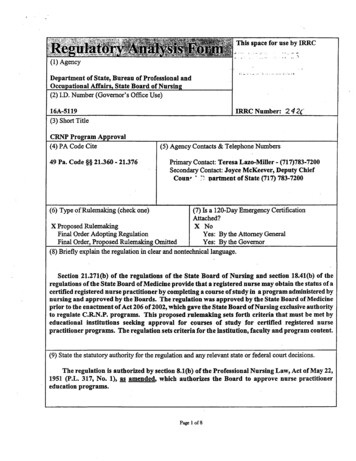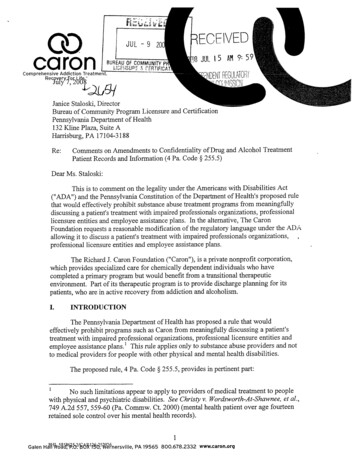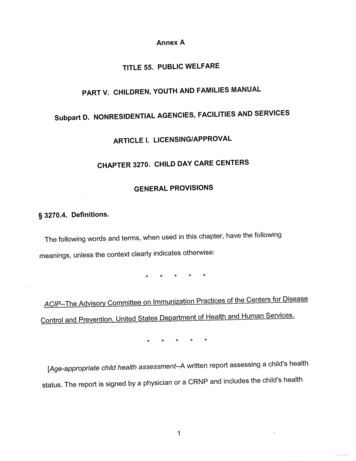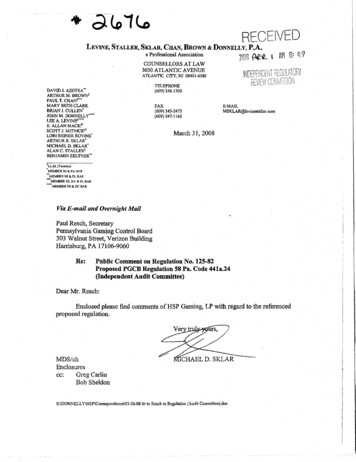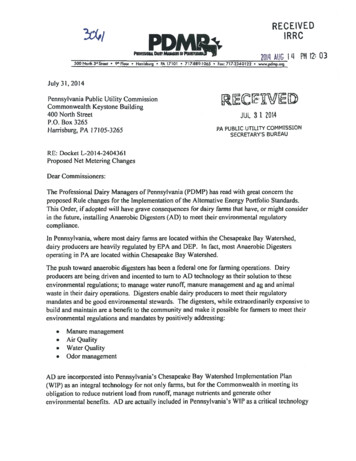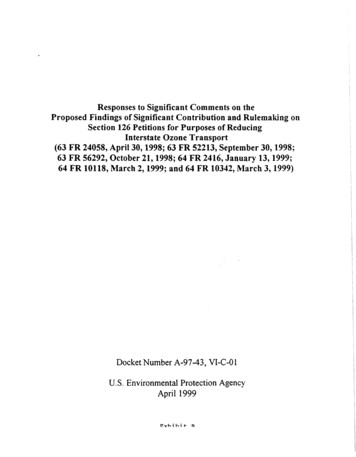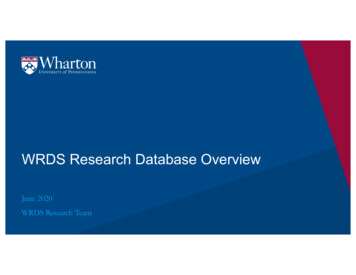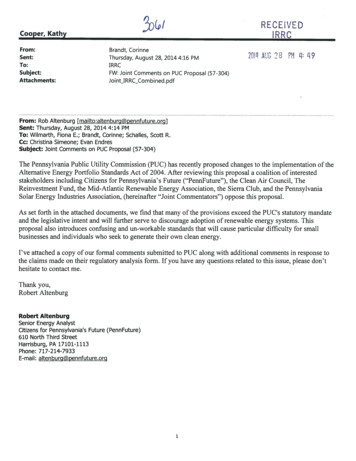
Transcription
RECEIVEDIRRCCooper, KathyFrom:Sent:To:Subject:Attachments:Brandt CorinneThursday, August 28, 2014 4:16 PMIRRCFW: Joint Comments on PUC Proposal (57-304)Joint IRRC Combined.pdf‘rnji’r’ ‘r)ViI.‘From: Rob Altenburg [mailto:altenburci pennfuture.org]Sent: Thursday, August 28, 2014 4:14 PMTo: Wilmarth, Fiona E.; Brandt, Corinne; Schalles, Scott R.Cc: Christina Simeone; Evan EndresSubject: Joint Comments on PUC Proposal (57-304)The Pennsylvania Public Utility Commission (PUC) has recently proposed changes to the implementation of theAlternative Energy Portfolio Standards Act of 2004. After reviewing this proposal a coalition of interestedstakeholders including Citizens for Pennsylvania’s Future (“PennFuture”), the Clean Air Council, TheReinvestment Fund, the Mid-Atlantic Renewable Energy Association, the Sierra Club, and the PennsylvaniaSolar Energy Industries Association, (hereinafter “Joint Commentators”) oppose this proposal.As set forth in the attached documents, we find that many of the provisions exceed the PUC’s statutory mandateand the legislative intent and will further serve to discourage adoption of renewable energy systems. Thisproposal also introduces confusing and un-workable standards that will cause particular difficulty for smallbusinesses and individuals who seek to generate their own clean energy.I’ve attached a copy of our formal comments submitted to PUC along with additional comments in response tothe claims made on their regulatory analysis form. If you have any questions related to this issue, please don’thesitate to contact me.Thank you,Robert AltenburgRobert AltenburgSenior Energy AnalystCitizens for Pennsylvania’s Future (PennFuture)610 North Third StreetHarrisburg, PA 17101-1113Phone: 717-214-7933E-mail: altenburg@pennfuture.org1
RECEiVEDIRRCPennture.,CenwiL! 5OCitizens for Pennsylvania’s Future610 N. Third St.Harrisburg, PA 17101-1113thEontAugust 28, 2014John F. Mizner, Esq.ChairmanIndependent Regulatory Review Commission333 IViarket Street, 14th FloorHarrisburg, PA 17101Re: ID Number 57-304PUC Docket No. L-2014-2404361Dear Chairman MiznerThe Pennsylvania Public Utility Commission (PUC) has recently proposed changes to theimplementation of the Alternative Energy Portfolio Standards Act of 2004. After reviewingthis proposal a coalition of interested stakeholders including Citizens for PennsylvaniasFuture (“PennFuture”), the Clean Air Council, The Reinvestment Fund, the Mid-AtlanticRenewable Energy Association, the Sierra Club, and the Pennsylvania Solar EnergyIndustries Association, (hereinafter “Joint Commentators”) oppose this proposal. As setforth in the attached documents, we find that many of the provisions exceed the PUCsstatutory mandate and the legislative intent and will further serve to discourage adoptionof renewable energy systems. This proposal also introduces confusing and un-workablestandards that will cause particular difficulty for small businesses and individuals who seekto generate their own clean energy. We urge the Commission to join us in opposing thisproposal.Sincerely,Robert AltenburgSenior Energy Analyst,Citizens for Pennsylvania’s Futureend: Joint Comments submitted to PUCJoint Comments on PUC’s Regulatory Analysis Form Submissioncc: Corinne R. Brandt, Regulatory Analyst (via email)Scott R. Schalles, Regulatory Analyst (via email)Fiona E. Wilmarth, Dir. Regulatory Review (via email)
Joint CommentsPUC’s Regulatory Analysis Form SubmissionID Number 57-3041RAF Block 8: Lack of Stautory AuthorityThe PUC has provided specific statutory citations to justify its authority to enact theproposed regulation, however the proposal exceeds this authority.The Legislature established the Alternative Energy Portfolio Standards Act’ (the Act)with the intent of promoting the installation of renewable energy systems such as solarphotovoltaic (PV) systems. In the Act, the Legislature included unambiguous standardsfor what size units qualify as “customer-generators” 2provides clear requirements forvirtual net metering.3 And, most importantly, the Act guarantees that suchcustomer-generators “shall receive the full retazl value for all energy produced” As ourattached comments demonstrate the PUC’s proposal includes numerous changes that areinconsistent with these requirements.The PUC justifies the proposed changes, in part, claiming they will “balance the benefitsprovided to developers, owners, of alternative energy systems, and net metering customergenerators with the costs born by EDCs, EGSs, and electric utility ratepayers “ Whilethe desire to “balance the benefits” is understandable. the Act gives them the limitedauthority to “develop technical and net metering interconnection rules” 6 When it comesto broad matters of energy policy, their obligation is to carry out the “full intent” of the7 and not to conduct independent balancing of the various interests.Legislature.RAF Block 10: Lack of Compelling Public Interest and Benefits2In passing the Act. the Legislature made a finding that there was a significant publicinterest in promoting renewable energy. Contrary to the intent of the Legislature, thisproposal creates added restrictions and introduces confusion that could only limit theinstallation of solar PV systems and other renewable energy sources.We understand the intent of the PUC is to prevent merchant generators from receiving netmetering benefits reserved under the Act for customer-generators. We are sympathetic tothat goal, but we are unaware of any actual case where the PUC or Electric DistributionCompanies(EDCs) will likely be compelled to provide merchant generators with such17323§P.S. § 1648.1 et seq.1648.2§ 1648.55RAF Block 10673 P.S.§ 1648.5‘66 Pa.C.S. § 501(a)1
benefits under the existing rules. Lacking a demonstration of actual need, we do riot agreethat the PUC has documented compelling public interest supporting the proposed changes.The PUC also suggests that this proposal will increase “regulatory certainty”. While thereis value in such certainty, we find the proposed rule creates more ambiguity than it resolvesand to the extent that it does propose clear standards, the statements are often at oddswith the statutory requirements.3RAF block 12: Comparison with other statesWhile the Joint Commentators do not dispute that other states have similar restrictions tothe 110% limit the PUC proposed, the existence of restrictions in other states does not givethe PUC authority to enact limitations on system size that are more restrictive than thoseestablished by the Legislature.4RAF Block 14: Lack of Public InputWe appreciate the fact that the PUC staff has been receptive to informal communicationson this and many other issues, but we feel the interests of the regulated community andthe public would be better served in this case by a more formal stakeholder process. TheAct specifies that “The commission shall convene a stakehoider process to developStatewide technical and net metering rules for customer-generators.”8 The Jointcommentators, like the Legislature, believe that robust stakeholder input results in betterpolicy decisions. Had such a process been held, many of the issues commentators are nowraising could have been addressed before the proposal was issued.RAF Block 17: Harm to Individuals and Small Businesses5The Joint Commentators support the proposed metering requirements described in block17, but note that there are other impacts that should also be discussed.The change in language to authorize new fees is of particular concern. While the Actrequires customer-generators receive the full retail value for the power they generate, thePUC proposes adding broad new language stating they can approve fees that applyspecifically to customer-generators and not to other customers. This provision may have a. While even modest fees will9substantial impact on individuals and small businessesdiscourage installation of alternative energy systems, the mere presence of this language isharmful. Should the proposed change encourage EDCs to seek PUC orders allowing themto charge such fees, individuals and small business could incur significant expensesintervening in cases to oppose those fees, even if they are not ultimately approved.8§ 1648.59Joint Comments. hA.2
While fees are a direct impact, there are also indirect impacts caused by arbitrarystandards. For example, while the statute requires that customer-generators be permittedto engage in virtual net metering on properties within two miles of each other. the PUCproposes to add a additional requirement that all of those parcels must have anindependent load. Under this proposal a business could purchase an adjacent lot to installsolar panels that connect to its existing meter but an otherwise identical competingbusiness could not purchase a vacant lot across the street without the expense of moving aportion of its operations to that lot to establish an existing load.’0 The financial impact ofsuch arbitrary restrictions should be addressed.The proposal may also force inefficient use of resources. Under the existing rules, a smallfarm may install a biodigester with the capacity to handle their entire manure load. Underthe proposed rules, they could be forced to install a smaller unit and truck their excesswaste for off-site disposal. Even though their primary business is agriculture, they couldfall under the proposed definition of a utility” or be artificially limited by the proposed110% cap if their system generates more electricity than they use.6RAF Block 18: Benefits do riot Outweigh HarmsWe disagree with the PUC’s assertion that the proposed regulations “will reduceuncertainty for all stakeholders.”This is particularly obvious in the case of the proposed 110% cap as applied to residentialcustomer generators. As we documented in our comments’2 there is little risk that amerchant generator will disguise itself as a residential customer-generator, so this will dolittle to forward the PUC’s stated goals. This may create a substantial burden for thecustomer because many residential consumers will lack the financial resources orengineering skill to independently assess their situation and challenge denials from theirEDCs. The PUC has stated that it intends the limit to be a flexible standard as opposedto “a hard kilowatt-hour cap on the customer-generator’s system output” ,‘ but this veryflexibility negates “the benefits of obtaining more certainty” on which the PUC relies tojustify the proposal.7RAF Block 19: Underestimating Compliance CostsThe PUC maintains, without supporting documentation and without conducting a coststudy, that added compliance costs will be offset by “avoided costs attributable to theincreased regulatory certainty.” For the prospective customer-generator, particularlyindividuals and small-businesses, there is little in this proposal that adds any certainty and‘ Joint Comments, II.D.“Joint Comments, JIB.Joint Comments, lIE. pp.9—102‘1344Pa.B. 4182 (Proposal at B.1.)3
many provisions that can be used by EDCs to deny customers their rights under the Act.For example, a EDC could deny a family the ability to be a customer-generator at theirnewly constructed house because they are unable to document an existing load,’4 or theEDC could deny their request because the EDC determines the capacity of their systemexceeds 110% of their load.’5 Without any historical data to rely on, the homeowner wouldbe forced to concede and install a smaller system, forgoing the added benefits, or pay forlegal and engineering services to challenge the determination. This situation iscompounded because the PUC proposes to eliminate its ability to appoint a technical6 to aid in the dispute.master’As an another example, if a small business decides to install an electric vehicle chargingstation in its parking lot, it risks being labeled a “utility” under the proposed rules’7 forproviding a de minirnis amount of electricity at retail. This would disqualify that smallbusiness from being a customer-generator. While this business may ultimately file acomplaint with the PUC regarding this decision, that could involve a considerable expense.The added uncertainty can only discourage the installation of alternative energy systemsand the increased burden on applicants should be considered with the compliance costs.8RAF Block 22: Record Keeping DifficultiesThe Joint Commentators maintain that demonstrating an alternative energy systemprovides no more that 110% of a customer’s historical load may be burdensome,particularly for individuals and small businesses. The most obvious case is that of newconstruction where there is no historical data on which to rely. The proposal is silent onhow this situation should be handled. If, as discussed above, prospectivecustomer-generators can estimate their load, they must absorb additional costs for theanalysis. If actual historical data is required, it effectively prohibits net metering until ausage record is established.Even in the case of houses with an existing load, just looking up old bills risks creatinginequities. Assuming two neighbors with identical homes each want to install the largestpermissible solar systems, if one of them has already invested in insulation,weatherstripping, and efficient LED lightning, that neighbor is, in effect, penalized in the110% calculation. If the EDC is willing to allow the neighbor to estimate load without theefficiency improvements, once again an extensive analysis wo,,ld be required.‘J4oint Comments, TIC.Joint Comments, TIE.5‘1644Pa.B. 4185Joint Comments. II.B.7‘4
9RAF Block 24: Impacts on Small BusinessesThe Joint Commentators note that, in evaluating the impact on small businesses, the PUCincludes the EDCs, EGSs, and system installers but neglects to include the smallbusinesses and farms who are current or prospective customer-generators that will beharmed by the added restrictions and increased uncertainty associated with this proposal.10RAF Block 26: Least Burdensome AlternativeThe Joint Commentators are concerned that PUC reports no other alternative provisionswere considered and rejected. If this is actually the case, this strongly supports the needfor a robust stakeholder process as suggested in block 14.There are clearly other alternatives to consider. For example, we make the case in ourJoint Comments for excluding residential customers from the 110e cap on generationbecause the benefits are unlikely to justify the burden.’811RAF Block 27: Regulatory Flexibility AnalysisThe Joint Commentators note that this response is incomplete as it does not include theimpacts on current or potential customer generators beyond stating that one aspect of theproposal does not typically apply to small businesses.12RAF Block 28: Failure to Describe the Basis for the ProposalWe are concerned that the PTJC’s answer under this block is insufficiently responsive to thequestion for anyone to formulate an opinion as to the basis for the proposal.The PUC relies on it’s “Experience implementing the AEPS Act” and on the 2012 AEPSAnnual Report. The Annual Report describes the regulatory history of the program andsome elements of the existing program, but does not contain any data documenting flawsin the program that must be corrected. If experience is going to be used as the sole basisfor the regulation, we suggest that the PUC cite specific cases in the docket, or specificcorrespondence, documenting the need for the proposed changes.The Joint Commentators are aware of two cases raising similar issues—those of Larry9 If these, or other cases, represent the “experience” inMoyer and of Sunrise Energy.’question the IRR.C and public should be so informed. Without knowing the specific issues“Joint Comments at 9.Larry Moyer v. PPL Electric Utilities Corp. (Docket C-2011-2273645), Sunrise Enerqy v. PUC (Pa.9‘Cmmw. Docket 642 CD 2014)
that motivated the rulemaking, it is difficult for any outside party to propose reasonablealternatives.Furthermore, if this is a case where PUC is “balancing the benefits” as they- have suggestedabove, we recommend they review the report Value of Distributed Solar ElectricGeneration to New Jersey and Pennsylvania20 that documents the significant system-widevalue such systems provide.13RAF Block 30: Evaluating EffectivenesWe reiterate the suggestion that any future determinations be made after a formalstakeholder process.p Perez. et. al. Value of Distributed Solar Electric Generation to New Jersey and Pennsylvania20(November, 2012) (available at: http: //mseia.iet/site/wp-content/up1oads/20 1 2/05/MSEIA-Final-Benefitsof-Solar-Report-201 2-11-01 .pdf)6
ALAugust 28, 2014PennFunnESubmitted ElectronicallyRosemary Chiavetta, SecretaryPA Public Utility CommissionPost Office Box 3265Harrisburg, PA 17105RE:Implementation of the Alternative Energy Portfolio Standards Act of 2004,Docket No. L-2014 2404361Dear Secretary Chiavetta,MAIlERMIDRTLRNTKOn behalf of the undersigned advocates for robust and appropriate net meteringregulations in Pennsylvania, we submit the following comments for considerationin the matter of the proposed changes to net metering regulations in Pennsylvania.RENEWABLE ENERGYPlease contact us if you have additional question or require additional information.PASEN*Thank you,R55OCATONERRAcS’BRob AltenburgSenior Energy AnalystPennFuture Energy CenterF’dRonald CelentanoPresidentPennsylvania Solar Energy Industries Association (PASEIA)Thomas SchusterSenior Campaign RepresentativeSierra Club
‘/6’Vera ColePresidentMid-Atlantic Renewable Energy Association (MAREA)MAREAMIDATLANTICrENEuA13Joseph Otis Minott, Esq.Executive DirectorClean Air CouncilNR( -,‘Hcz( cAT-.SiERRAsJThEcçr’fFdRoger ClarkFund ManagerSustainable Development Fund
BEFORE THEPENNSYLVANIA PUBLIC UTILITY COMMISSIONImplementation of theAlternative Energy Portfolio StandardsAct of 2004)))Docket No. L-2014-2404361))COMMENTS OF JOINT COMMENTATORSI. IntroductionCitizens for Pennsylvania’s Future (“PennFuture”); the Clean Air Council, The ReinvestmentFund, the Mid-Atlantic Renewable Energy Association, the Sierra Club, and the PennsylvaniaSolar Energy Industries Association, (hereinafter “Joint Commentators”) summit thesecomments in response to the Public Utility Commission’s (“Commission”) ProposedRulemaking Order (“PRO”) in Docket No.L-2014-2404361 concerning the implementation ofthe Alternative Energy Portfolio Standards Act of 2004 (“AEPS” or “the Act”) entered onFebruary 20, 2014 and published in the Pennsylvania Bulletin on July 5, 2014.PennFuture is a non-profit, membership-based environmental advocacy organization focusing onland, air, water, and energy issues that impact Pennsylvania. Headquartered at 610 North ThirdStreet, Harrisburg, PA 17101 with offices in Philadelphia, Pittsburgh, and Wilkes-Barre,PennFuture works to create a just future where nature, communities and the economy thrive.The Clean Air Council is a non-profit environmental organization headquartered at 135 South19th Street, Suite 300, Philadelphia, Pennsylvania 19103. For more than 40 years, the Councilhas fought to improve air quality across Pennsylvania. The Council has members throughout theCommonwealth who support its mission to protect everyone’s right to breathe clean air.The Reinvestment Fund (“TRF”) is a non-profit community development financial institutionlocated at 1700 Market Street, 19th floor, Philadelphia, PA 19103. TRF was selected by theCommission in 1998 to manage the Sustainable Development Fund, which was created by thesettlement agreement of the electric utility restructuring proceeding for PECO. SDF hassupported solar, wind and other clean energy projects in Pennsylvania and has providedfinancing for building energy efficiency projects.The Mid-Atlantic Renewable Energy Association is a 501(c)(3) non-profit dedicated toinforming and educating the public on renewable energy production, energy efficiency, andsustainable living through meetings, workshops, educational materials and energy fairs.
The Sierra Club is America’s oldest, largest, and most influential grassroots environmentalorganization, with over 24,000 members in Pennsylvania. The Club promotes conservation byinfluencing public policy through grassroots activism, public education, lobbying, and litigation.We work to defend the environment at all levels of government including U.S. Congress, statelegislatures, and state and federal courts.Pennsylvania Solar Energy Industries Association C’PASEIA”) is the Pennsylvania division ofMid-Atlantic Solar Energy Industries Association (MSEJA’). which is a not-for-profit tradeassociation of companies, businesses and professionals working in Pennsylvania, New Jerseyand Delaware involved in the development, manufacturing, design, construction and installationof solar photovoltaic (“PV’) and solar thermal systems.The Purpose of the AEPS Is to Promote Alternative EnergyThe preamble to the AEPS begins, ‘An act providing for the sale of electric energy generatedfrom renewable and environmentally beneficial sources, for the acquisition of electric energygenerated from renewable and environmentally beneficial sources by electric distribution andsupply companies.This purpose to promote the purchase of renewable energy by electricdistribution and supply companies is furthered by a robust net metering program under which[e]xcess generation from net-metered customer-generators shall receive full retail value for all2 Restrictions on such a program that provide customerenergy produced on an annual basis.”generators less than that full retail value, that do not promote efficient operation, that restrictavailability, or that result in inconsistent interpretations of rules between service territories clashwith the overall policy objectives of the AEPS.The Joint Commentators respectfully submit the following comments calling the Commission’sattention to issues in the Proposed Rulemaking Order (“PRO”):3II. Comments on the Proposed Rulemaking OrderA.We oppose the proposed changes to §75.13(k) that would give the Commissionauthority to allow utilities to charge new fees to customer-generators.The PRO proposes to amend §75.13(k) by adding new language at the end of the section: “An[electric distribution company] EDC or [default service providerl DSP may not charge acustomer-generator a fee or other type of charge unless the fee or charge would apply to othercustomers that are not customer-generators, or is specifically authorized under this chapter or by4order of the Commission.”S.B. 1030 P.N. 1973 (enacted as 73 P.S. § 1648.1 ctseq.)(November3O, 2004)P.S. § 1648.5344 Pa.B. 4179 —4194444 Pa.B. 4190, PRO 75.13(k) (emphasis added)§22
In the Discussion section of the PRO, the Commission states its intent for this change was toallow EDCs or DSPs the ability to recover their administrative costs of setting up and billingvirtual net metering accounts, as provided for in §75.14(e). But instead, the actual proposedlanguage allows fees to be charged on any net-metered customer, not just customers whoseaccounts are aggregated through virtual net metering. Even more problematic is the fact that theproposed language does not restrict the fee to the administrative costs of aggregating and billingvirtual net metered accounts. There is nothing in the proposed language that would prevent anEDC or DSP to request (and a future Commission to approve) a new charge to compensate forthe customer-generator’s use of the distribution system or the cost of maintaining generationcapacity for times when the customer-generator’s system is not generating electricity.The Joint Commentators believe the new §75.13(k) language needs to be rewritten so that it isfirmly within the limits of’75.l4(e). As the proposed new language in §75.13(k) now stands, itclearly violates the AEPS guarantee that net metered customers receive the full retail rate for allgeneration they produce up to their annual usage. A fee would erode that right to full retail rate.In addition, charging additional fees to those who install alternative energy systems isunnecessary and will increase compliance costs and result in slower adoption of such systemscontrary to the purposes of the Act. Furthermore, we are concerned that adding this provisionwill encourage EDCs and DSPs to seek such fees creating a financial burden on residential andsmall-business system owners who have or are looking to install alternative energy generation attheir homes or businesses.Moreover, the proposed change fails to provide any basis for determining this fee. If there is tobe a fee, it should be based on a full cost of service study that evaluates both the costs and thebenefits of each specific net metered system such as the recently completed Value ofDistributedSolar Electric Generation to New Jersey and Pennsylvania5 analysis commissioned byPASEIA/MSEIA, which found that solar power delivers a premium value in the range of 150 to 200 per MWh (15 cents to 20 cents per kwh), above the value of the solar electricity generated.The new language should be clarified such that it clearly applies only to the administrative costsof billing virtual net-metered systems.B.We believe the proposed new definition for “utility” in §75.1 is overly broad andthreatens the third-party ownership model for solar and other distributedgeneration which the Commission has approved in prior dockets.while the Discussion section of the PRO indicates the new definition of “utility” is designed toallow non-electric utilities such as water and wastewater utilities to qualify as a customergenerator, the ‘utility” definition could be interpreted to apply to solar and other alternativeenergy developers who build and own systems and sell the output to the host customer through along-term power purchase agreement. We urge the Commission to amend the definition ofAvailable at http://mseia.net/site!wp-contem/uploads/20 1 2/O5/MSE1A-Final-Beneflts-of-Soar-Report-2O 12-11OIpdf.644Pa.B. 41813
“utility” so it explicitly preserves the ability to use a third-party ownership business model fornet metered systems.The Commission defines Customer-generator, in part, as a “nonutility.” Therefore anunderstanding of customer-generator will be impacted by the definition of Utility. Troublingly,the Commission provides conflicting definitions in its discussion in part A.4 of the PRO and theproposed language in Annex A at § 75.1. The Joint Commentators are concerned that thedefinition in Annex A is overbroad and may cause confusion and inconsistent implementation ofnet metering programs.The Order says “we have defined a utility in this context as a person or entity whose primarybusiness is electric generation, transmission, or distribution services, at wholesale or retail, toother persons or entities.”7 Annex A, on the other hand, defines the term more broadly asfollows: “A person or entity that provides electric generation, transmission or distributionservices, at wholesale or retail, to other persons or entities.” Critically, the Annex A languagedoes not restrict the definition of utility to entities whose primary business is electric generation,transmission, or distribution.Under the definition in Annex A, for example, a small-business who wishes to install an electricvehicle charging station selling a trivial amount of electricity to its customers and employeescould risk being labeled a “Utility” and would no longer qualify as a customer-generator. TheAnnex A language could also apply to a solar PV developer who used a third-party ownershipmodel to own a new solar system and “sell” the electricity to the host property power through apower purchase agreement. The efficacy of this business model for deploying solar and otherdistributed generation has been recognized by the Commission is earlier Orders,8 but isthreatened by this broad definition of Utility. The Joint Commentators recommend that theAnnex A definition be restricted to those whose primary business is generation.C.The Legislature does not require customer-generators to actually purchase power.The AEPS defines Customer-generator as ‘[al nonutility owner or operator of a net metereddistributed generation system with a nameplate capacity of not greater than 50 kilowatts ifinstalled at a residential service or not larger than 3,000 kilowatts at other customer servicelocations.The Commission maintains that the use of the term “Customer” as part of thisdefinition implies “[t]he person or entity must purchase electricity or electric service to beconsidered a customer under the AEPSThe Joint Commentators maintain that requiringactual purchase of power is an unnecessary extension of the definition, will add to customerconfusion, and is contrary to the intent of the Act.“744Pa.B. 4181, PRO at A.4. (emphasis added)Net Metering Use of Third Party Operators, (Docket M-201 1-2249441), (March 29, 2012)73P.S. 1648.291044PaB. 4181, PRO at A.4.8—4
In drafting the Act, the Legislature contemplated situations where customer-generators go foryears at a time with no net consumption of electricity.11 The Commission has also recognizedthis possibility in regulation.12 If actual net purchase of electricity were required, this wouldcreate a situation where one could not be a customer-generator if such a system was installed at anewly constructed house, but one would be a customer generator if the exact same system wereinstalled at an identical house after the new owners paid their first power bill. This is an absurdresult.The plain text of the Act specifies that distributed generation systems are those installed at“customer service locations.” In context, this definition is most reasonably interpreted to meanthose service locations where a party has the potential to take power from the grid if needed.The Commission’s stated goals of limiting merchant generators from receiving undue benefitscan be adequately accomplished with other provisions, discussed below, s
Harrisburg, PA 17101-1113 August 28, 2014 John F. Mizner, Esq. Chairman Independent Regulatory Review Commission 333 IViarket Street, 14th Floor Harrisburg, PA 17101 Re: ID Number 57-304 PUC Docket No. L-2014-2404361 Dear Chairman Mizner The Pennsylvania Public Utility Commission (PUC) has recently proposed changes to the
